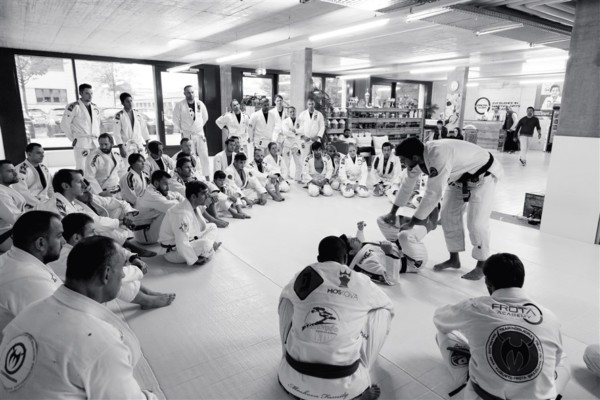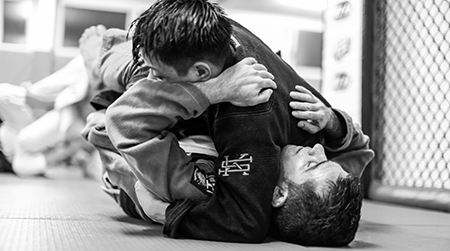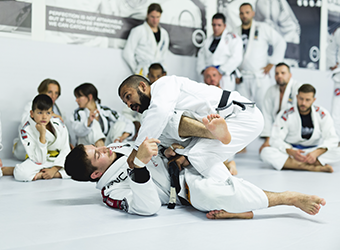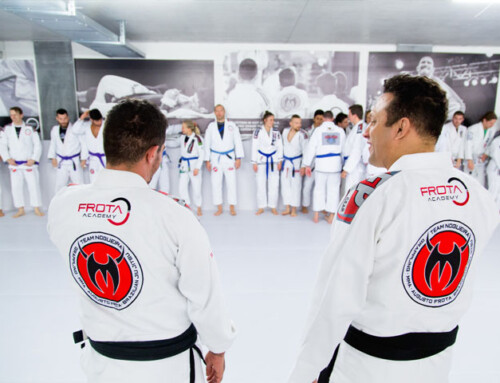Every jiu-jitsu athletes needs to have solid guard passing fundamentals. Even if you love to play guard, there are times when you will have to be on top and know how to defend and attack. Plus, there is one major advantage you have when playing from the top; gravity. Understanding how to properly use your weight to pressure your opponent, make them tired, and break down their guard will make you much more successful in passing guards and winning matches. Here are a few key things to think about to become a better guard passer.
1. Understand The Different Ways To Pass A Guard (Around, Through, Under)
There are many ways to pass a guard. Some like to pass from their feet and use lateral movement and foot work to get by their opponent’s legs an into side control This style of passing usually involves going AROUND the guard, either to the left or right of the legs, to pass. Typically, fast, athletic types prefer this style of passing, as they can use their natural abilities to out maneuver their opponent. Examples of this type of passing would be tornado passing, long steps, the X pass, and throw by passing.
Others like to go THROUGH guards, meaning splitting the legs and passing through the middle. Passing in this style requires getting right into the mix of things, which can set you up for attacks like triangles, omoplatas, armors and sweeps, so you must be aware. Going through the guard can use a combination of pressure and footwork but usually involved closing the space between you and your opponent and being aggressive in your effort to reach the upper body. Examples of this type of passing include knee cuts, over/under passing, half guard passing, Sao Paulo passing and others.
You can also pass by going UNDER the guard. In this style of passing you get beneath your opponents legs in order to work your way around them. Passing in this manner can be also be combination of pressure and lateral movement. The stack pass is a great example of going under your opponent’s guard. You stack both of their legs on your shoulder or over their own head with your body underneath. Then you work around to side control using pressure and lateral movement. The Berimbolo or crab ride can also be considered a pass under the guard.
Understanding the different ways to pass a guard can help you conceptualize how to reach your goal, the side control or mount.
2. Link different passing styles
The best guard passers link different passing styles, around, through, and under, together to get to side control. Often times, your opponent will be skilled in defending against a certain style of pass, however, when you are constantly changing your passing styles you can gain the advantage to pass. An example of linking two passes together would be starting with a tornado pass then instead of throwing the legs by you stock your opponents leg over their head. From there you can start to use pressure to close the space and pass.
Another example would be attempting an over/under pass and switching to a long step, or driving in for the knee cut and switching from there to the over/under.
Not every pass will work on every opponent, however when you begin to link passes together you will be much more successful in your passing.
3. Control the head
Theres a saying, “control the head, you control the body.” Often times when you can get a grip on your opponents upper collar or around the head you will be in a much better position to pressure in and pass their legs. WIth their upper body pinned or under control you take away the mobility in their spine to defend, escape, and mount an offense. Some of the best passers in history won many world titles by getting head control first, and never letting that grip go while patiently untangling their legs and making it to side control.
Work hard to control your opponents head and you will control the fight, leading to a higher passing rate.
4. Break Grips
Too often passers allow guard players to get their preferred grips and maintain them. Grips are massively important for the guard player to set up attacks like submissions and sweeps. Without proper grips, guard players can’t break your posture, unbalance you, or successfully employ the techniques they prefer. Be relentless in breaking grips. Never allow your opponent to make a grip on your collar or sleeves. If they make a grip, break it. If they insist on making it again, break it again.
Grip breaking is often a war of attrition. The man who quits the gip breaking game first is often then a step behind.
Break grips often and with authority!
5. Be Patient, Be Persistent
Guard passing requires patience and persistence. If you act too soon you can get caught in a submission trap or off balance and swept. Don’t be over anxious to get the pass. This will cause you to miss steps in your technique and ultimately fail the pass attempt.
Guard passing can also be very frustrating, especially when your opponent has a pesky guard and good guard retention. Many times you will get very close to passing the guard, only to be pushed away and put back into the guard. The best passers don’t get frustrated. They are persistent in their attacks and are insistent on getting to side control, mount, or back control.
Guard passing is also tiring. It sometimes takes a lot of effort and energy to pass the guard and repeat guard pass attempts over and over. A strong mind will serve you well as a guard passer. Look at the guard as a puzzle. Every puzzle can be solved, and every guard can be passed. Just stay patient and stay persistent and you too shall pass!










